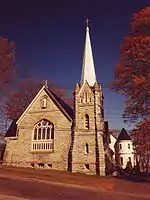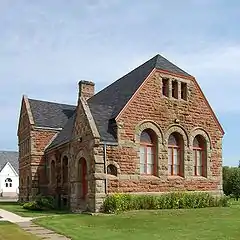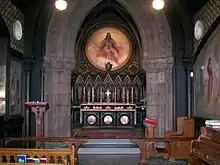William Critchlow Harris
William Critchlow Harris (30 April 1854 – 16 July 1913) was an English-born Canadian architect noted mainly for his ecclesiastical and domestic projects in Maritime Canada.
William Critchlow Harris | |
|---|---|
| Born | 30 April 1854 |
| Died | 16 July 1913 (aged 59) Halifax, Nova Scotia, Canada |
| Nationality | Canadian |
| Occupation | architect |
He was born near Liverpool, England to Welsh parents but moved to Prince Edward Island with his family as a young child. He lived there most of his life, however for much of the time he led an itinerant existence travelling throughout Prince Edward Island, New Brunswick and Nova Scotia pursuing and executing design commissions throughout the region. He was influenced by the Richardsonian Romanesque architectural style (for his domestic buildings) and Victorian gothic (for his church designs).
His greatest disappointment was the loss of a commission late in life to design the Anglican Cathedral in Halifax (1905-1910). The commission was awarded to New York City architect Bertram Goodhue and Harris was given the unhappy task of overseeing completion of the more famous architect's work.
His brother was the noted artist Robert Harris.
Notable works

 St. John's Church 1898 & rectory 1898 in Windsor, Nova Scotia
St. John's Church 1898 & rectory 1898 in Windsor, Nova Scotia Georgetown, Prince Edward Island Kings County Provincial Court House
Georgetown, Prince Edward Island Kings County Provincial Court House Hensley Chapel Kings Edgehill
Hensley Chapel Kings Edgehill
- Broughton, Nova Scotia (plan and buildings), Glace Bay, Nova Scotia
- Frederick Borden house, Canning, Nova Scotia
- Elmwood House, Charlottetown, PEI
- St. James Anglican Church, Mahone Bay, Nova Scotia (one of the famous Three Churches)
- St. Mary's Church, Indian River, PEI
References
- Tuck, Robert C., Gothic Dreams: The Life and Times of a Canadian Architect William Critchlow Harris 1854-1913. Toronto: Dundurn Press, 1978.
| Wikimedia Commons has media related to William Critchlow Harris. |